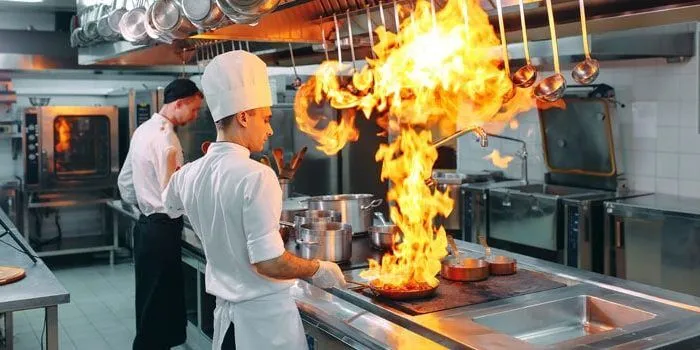Introduction
Running a restaurant is a complex and demanding endeavor, requiring not only culinary talent but also the right tools and equipment to bring a chef’s vision to life. Restaurant equipment encompasses a wide array of specialized tools, appliances, and machinery that are essential for the preparation, cooking, and serving of food. These pieces of equipment are the backbone of a restaurant’s operations, enabling efficiency, consistency, and safety in the kitchen. Whether you’re opening a new restaurant or upgrading an existing one, understanding the different types of restaurant equipment and how to select and maintain them is crucial for success. This article will delve into the various categories of restaurant equipment, their importance, the factors to consider when purchasing them, and tips for proper maintenance.
The Importance of Restaurant Equipment
The importance of restaurant equipment extends beyond merely facilitating the cooking process. The right equipment can significantly impact the overall efficiency of kitchen operations, the quality of the food served, and ultimately, the satisfaction of customers. Here’s how restaurant equipment contributes to the success of a culinary business:
- Operational Efficiency: In a busy restaurant kitchen, time is of the essence. Efficient equipment helps streamline the workflow, ensuring that food is prepared and served promptly. High-performance appliances, such as commercial ovens, stoves, and dishwashers, are designed to handle large volumes of food quickly and consistently, reducing wait times and improving customer satisfaction.
- Consistency in Quality: Consistency is key in the restaurant industry. Customers expect the same quality of food every time they visit. Restaurant equipment, such as mixers, slicers, and temperature-controlled ovens, ensures that food is prepared consistently, regardless of who is in the kitchen. This consistency helps build a restaurant’s reputation and keeps customers coming back.
- Food Safety and Hygiene: Maintaining food safety is a top priority in any restaurant. Equipment like refrigerators, freezers, and sanitizing dishwashers are essential for keeping food at safe temperatures and preventing contamination. Properly functioning equipment helps meet health and safety standards, reducing the risk of foodborne illnesses and the potential for fines or closures due to health code violations.
- Cost Efficiency: Investing in high-quality restaurant equipment can lead to significant cost savings over time. Durable, energy-efficient appliances reduce the need for frequent repairs and lower utility bills. Additionally, equipment that helps manage portion sizes and reduce waste can also contribute to a more profitable operation.
- Scalability: As a restaurant grows, so do its operational needs. Scalable restaurant equipment allows a business to expand its menu offerings and increase production capacity without sacrificing quality. Modular kitchen designs, for example, can accommodate new equipment as the business grows, ensuring that the kitchen can handle increased demand.
Categories of Restaurant Equipment
Restaurant equipment can be broadly categorized into several key areas, each serving a specific function in the kitchen. These categories include cooking equipment, refrigeration, food preparation, storage, warewashing, and dining room essentials.
- Cooking Equipment:
- Ovens: Ovens are indispensable in any restaurant kitchen. There are several types of commercial ovens, each suited to different cooking methods:
- Convection Ovens: These ovens use fans to circulate hot air, ensuring even cooking. They are ideal for baking, roasting, and reheating.
- Deck Ovens: Often used in pizzerias and bakeries, deck ovens feature stone or metal decks where food is placed directly. They are known for producing crispy crusts on bread and pizza.
- Combi Ovens: Combining convection and steam cooking, combi ovens offer versatility in preparing a wide range of dishes. They are perfect for steaming vegetables, roasting meats, and baking pastries.
- Microwave Ovens: Commercial microwaves are powerful and fast, making them suitable for reheating and defrosting food in a busy kitchen.
- Ranges and Cooktops:
- Gas Ranges: Favored by many chefs for their precise temperature control, gas ranges are versatile and can be used for sautéing, boiling, frying, and more.
- Electric Ranges: Electric ranges offer even heating and are often more energy-efficient than gas ranges. They are suitable for kitchens where gas lines are not available.
- Induction Cooktops: Induction cooktops heat pots and pans directly using magnetic fields, offering energy efficiency and safety, as the cooktop itself remains cool to the touch.
- Grills and Griddles:
- Charbroilers: These grills are essential for adding a smoky flavor to meats, seafood, and vegetables.
- Flat Top Griddles: Used for cooking breakfast items like pancakes, eggs, and bacon, griddles offer a large, flat cooking surface.
- Fryers:
- Deep Fryers: Commercial deep fryers are used to cook a variety of fried foods quickly and evenly. They are essential in fast-food restaurants for items like French fries, chicken, and tempura.
- Countertop Fryers: These smaller fryers are ideal for establishments with limited space or for those that only need to fry smaller batches of food.
- Ovens: Ovens are indispensable in any restaurant kitchen. There are several types of commercial ovens, each suited to different cooking methods:
- Refrigeration Equipment:
- Refrigerators: Commercial refrigerators are available in various configurations, including reach-in, walk-in, and under-counter models. They are designed to keep perishable items fresh and safe at optimal temperatures.
- Freezers: Like refrigerators, commercial freezers are crucial for storing ingredients that need to be kept frozen. They come in reach-in and walk-in models, as well as blast freezers for rapidly freezing cooked food.
- Ice Machines: Ice machines are essential for producing ice for beverages, food displays, and cooling needs. They are available in different sizes and capacities to suit the needs of any establishment.
- Food Preparation Equipment:
- Mixers:
- Planetary Mixers: Common in bakeries and pizzerias, these mixers are versatile and can handle mixing, kneading, and whipping tasks.
- Spiral Mixers: Designed for dough preparation, spiral mixers are ideal for bakeries that produce large quantities of bread.
- Food Processors: These machines are used to chop, slice, dice, and puree ingredients quickly and efficiently. They are a time-saving tool in any kitchen, especially those with high-volume preparation needs.
- Slicers:
- Meat Slicers: Essential for delis and sandwich shops, meat slicers allow for precise slicing of meats and cheeses.
- Vegetable Slicers: These slicers ensure uniform cuts for vegetables, improving both the presentation and cooking consistency.
- Blenders:
- Bar Blenders: Used in bars and restaurants for mixing cocktails and smoothies.
- High-Performance Blenders: These are powerful enough to blend large quantities of ingredients, making them ideal for soups, sauces, and frozen drinks.
- Mixers:
- Storage and Handling Equipment:
- Shelving and Racks: Proper storage is critical in maintaining an organized kitchen. Stainless steel shelving units and racks are durable, easy to clean, and resistant to corrosion.
- Food Storage Containers: Airtight containers help keep ingredients fresh and prevent cross-contamination. They come in various sizes and materials, such as plastic, glass, and stainless steel.
- Carts and Trolleys: Used for transporting food, dishes, and equipment around the kitchen and dining area, carts and trolleys are indispensable in any restaurant.
- Warewashing Equipment:
- Dishwashers:
- Conveyor Dishwashers: Ideal for large establishments, these dishwashers can clean large quantities of dishes quickly and efficiently.
- Under-Counter Dishwashers: These compact dishwashers are suitable for smaller kitchens or bars, offering efficient cleaning in a space-saving design.
- Sinks and Faucets:
- Compartment Sinks: These sinks typically have three compartments for washing, rinsing, and sanitizing dishes and utensils.
- Handwashing Sinks: Essential for maintaining hygiene standards, these sinks are strategically placed around the kitchen for easy access by staff.
- Waste Disposal Units: Garbage disposals and compactors help manage kitchen waste efficiently, reducing the volume of trash and maintaining cleanliness in the kitchen.
- Dishwashers:
- Dining Room Essentials:
- Tableware: Plates, bowls, glasses, and cutlery are fundamental components of any restaurant’s dining experience. The quality and style of tableware contribute to the overall ambiance and customer experience.
- Furniture: Comfortable and durable seating, along with aesthetically pleasing tables, are key elements of a restaurant’s interior design. The choice of furniture can significantly influence the dining experience.
- Beverage Equipment:
- Coffee Machines: From simple drip coffee makers to sophisticated espresso machines, coffee equipment is essential in many restaurants and cafes.
- Juicers and Drink Dispensers: These machines are used to serve fresh juices and cold beverages, often found in buffet settings or self-service stations.
Factors to Consider When Purchasing Restaurant Equipment
Investing in restaurant equipment is a significant decision that requires careful consideration. The right choices can enhance kitchen efficiency and contribute to the success of the business, while poor choices can lead to operational challenges and financial losses. Here are some key factors to consider when purchasing restaurant equipment:
- Menu and Concept: The type of cuisine and the restaurant’s concept will heavily influence the equipment needed. For instance, a bakery will require different equipment than a steakhouse. Ensure that the equipment aligns with the menu offerings and cooking techniques.
- Kitchen Layout and Space: The size and layout of the kitchen are crucial when selecting equipment. Measure the space available and choose equipment that fits comfortably, allowing for smooth workflow and accessibility. Modular equipment designs can be beneficial in maximizing space efficiency.
- Quality and Durability: Restaurant equipment is a long-term investment, so it’s important to choose high-quality, durable products. Stainless steel is a popular material for its strength, corrosion resistance, and ease of cleaning. Look for equipment from reputable brands that offer warranties and reliable customer support.
- Energy Efficiency: Energy costs can significantly impact a restaurant’s bottom line. Investing in energy-efficient equipment can lead to substantial savings over time. Look for ENERGY STAR-rated appliances, which are designed to reduce energy consumption without compromising performance.
- Ease of Use and Maintenance: Equipment that is easy to operate and maintain can reduce training time for staff and minimize downtime due to repairs. Consider features like intuitive controls, easy-to-clean surfaces, and readily available replacement parts.
- Compliance with Regulations: Ensure that the equipment meets local health, safety, and fire regulations. Non-compliant equipment can lead to costly fines and disruptions in business. It’s also important to stay informed about any changes in regulations that may affect the equipment used.
- Budget and Financing: While it’s important to invest in quality equipment, it’s also essential to stay within budget. Consider the total cost of ownership, including initial purchase price, operating costs, and maintenance expenses. Financing options, such as leasing, can help manage cash flow and make high-quality equipment more accessible.
- Scalability: As your restaurant grows, your equipment needs may change. Choose equipment that can scale with your business, such as modular kitchen systems or appliances that can handle increased capacity without requiring immediate replacement.
Maintenance and Care of Restaurant Equipment
Proper maintenance of restaurant equipment is vital for ensuring its longevity, performance, and safety. Regular maintenance not only helps avoid costly repairs but also ensures that the equipment operates efficiently and meets health and safety standards. Here are some tips for maintaining restaurant equipment:
- Daily Cleaning: Establish a routine for daily cleaning of all kitchen equipment. This includes wiping down surfaces, cleaning filters, and ensuring that no food residue is left on appliances. Daily cleaning helps prevent the buildup of grease and grime, which can lead to equipment malfunctions.
- Scheduled Maintenance: Follow the manufacturer’s recommended maintenance schedule for each piece of equipment. This may include tasks like calibrating ovens, checking refrigeration temperatures, and lubricating moving parts. Regular maintenance checks help identify potential issues before they become major problems.
- Prompt Repairs: Address any equipment malfunctions or issues immediately to prevent further damage. Delaying repairs can lead to more extensive damage and higher repair costs. Always use qualified technicians who are familiar with the specific brand and model of equipment.
- Proper Training: Ensure that all staff members are properly trained on how to use and care for the equipment. Misuse or neglect can lead to damage, increased wear and tear, and safety hazards. Training should cover operating procedures, cleaning protocols, and basic troubleshooting.
- Record-Keeping: Maintain detailed records of all maintenance and repairs. This documentation is useful for tracking the equipment’s performance, scheduling future maintenance, and managing warranties. It also helps when assessing the lifespan and replacement needs of the equipment.
- Energy Management: Monitor energy use and look for ways to improve efficiency. This can include simple measures like turning off equipment when not in use, regularly cleaning filters and coils to ensure optimal performance, and using equipment settings that match the task at hand.
- Regular Inspections: Conduct regular inspections of all kitchen equipment to ensure it is operating safely and efficiently. Look for signs of wear and tear, leaks, unusual noises, or other indicators that maintenance is needed. Regular inspections can help catch problems early and avoid costly downtime.
Conclusion
Restaurant equipment plays a crucial role in the success of any culinary operation. From cooking and refrigeration to food preparation and serving, the right equipment enables efficiency, consistency, and safety in the kitchen. Understanding the different types of equipment, the factors to consider when purchasing them, and the importance of proper maintenance is essential for any restaurant owner or operator. By making informed decisions and investing in high-quality equipment, restaurants can enhance their operations, deliver exceptional dining experiences, and achieve long-term success in a competitive industry.




